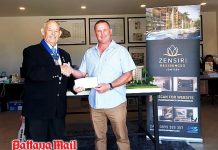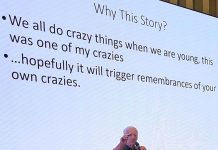
Member Stuart Saunders spoke of the adventures and misadventures of inventors at the August 27 meeting of the Pattaya City Expats Club (PCEC). Stuart has been inventing a broad range of products for over 50 years. His view of the invention industry concerned the state of big business and patent law worldwide.
Born in Sydney, Australia, he grew up in northeastern New South Wales. Stuart studied Industrial Design at the University of New South Wales, on a traineeship with British Leyland (later became Leyland Australia). While still a trainee, he invented a rear suspension for the ‘original’ Mini, with only 1 moving part for 2 wheels.

Upon graduation, he taught in North Queensland and then in Brisbane, continuing his inventing with specialist automotive differentials and four-wheel drive systems. He then developed a wireless stereo system, which earned him the Queensland Inventor of the Year Award, and which led him to Taiwan to manufacture it. Stuart broadened his inventing skills there with a more efficient computer CPU cooler, and designed and manufactured a pump-less vacuum-screen printer and a dryer. While living in Taiwan, he designed a comprehensive Urban Rail Line. Stuart won the Award for Engineering Excellence for his MRT Line at the 2013 Metro World Summit in Shanghai.
As an avid dental hygiene advocate, he always carried regular dental floss in his pocket, but found it uncomfortable. So, he designed a ‘comfortable’ dental floss, in a credit-card sized package. This package holds almost four times the normal length of floss and is now being manufactured in his Chonburi factory, under the name of “FlossFirst”. Since moving to Thailand, his environmental concerns led him to invent a cooker for Khao Larm (the delicious Thai rice dessert cooked in bamboo), called the ‘KhaoLarmAtorium’ that reduces CO2 emissions by 99%.
Stuart has now developed a new driveline for Electric Vehicles with many advantages in the areas of friction, weight, cost, performance and more. It used to have two moving parts, but he says he has since simplified it. But, he explained to his audience why this and some other inventions have not been manufactured; primarily due to the expense under current patent law which delays obtaining the patent while making the “invention” design details public. Likewise, he mentioned that he has found that in approaching manufacturing companies, they generally are reluctant to sign non-disclosure agreements, which makes it vulnerable to being made public.
How can that be? He then discussed the rights, or lack of rights, inventors have to protect their inventions as they bring ideas to market. Current patent law, he says, is not unlike asking newborns to pass university entrance exams, or be denied a birth certificate. This is why so many inventions lie dormant. He provided examples of how some inventions were actually stolen by manufacturers without paying royalties to the inventor.
One example was that of Edwin Howard Armstrong (1890 – 1954), considered the father of modern radio, was the inventor that advanced both AM and FM radio and held 42 patents, and numerous awards. Armstrong’s attempt to eliminate radio static led to an industry-creating breakthrough, broadband Frequency Modulation (FM). The radio industry had given up on FM, but at the end of 1933, Armstrong unveiled his invention. RCA had first rights, but made a calculated decision to squash it, focusing on AM and a new technology, “television”. Armstrong went into business for himself, delivering high-fidelity sound that by 1940, was the standard for quality broadcasts. Stuart said that patent litigation, and battles with government regulators colluding with RCA, derailed FM radio. His wife left him and he committed suicide in 1954. His wife, though, continued the patent battles, ultimately winning.
Founding the “Intellectual Property Rightful Owners Action Group (IPROAG)”, Stuart talked about the current challenges facing inventors everywhere. The patent system is supposed to encourage inventors to solve society’s problems, by granting them a limited monopoly on their inventions. However, the system has not worked for a long time. He showed a photo of inventors burning their patents in Washington as confirmation. Very specific laws govern what disclosures can be made and still have an invention protected, prior to filing a patent. Knowing what can be said, and where, and most importantly, what starts the clock running for an application, can mean the difference between getting a patent, or losing it.

IPROAG advocates changes to patent laws, allowing inventors to focus on their inventions rather than fighting big business and the overwhelming bureaucracy. Intellectual property costs discourage all but the wealthiest. IPROAGs “One Dollar Patent Act” includes an application process that starts within one year of an invention coming into the public domain, with strong criminal penalties for abuse. Application fee is one dollar – or one peppercorn or in Asia, perhaps, one grain of rice. The proposed Act provides for a 25-year time limit to provide final specifications to the patent office. This protects against irretrievable loss due to failure or inability of the inventor to fulfil the bureaucratic or fiscal demands of the patent system. Also included are inventor protections from invention promoters and attorneys, by imposing strict reporting requirements, and protection from hostile competition. Standardized non-disclosure agreements are proposed, as are piracy and counterfeiting issues. Retroactivity applies as well.
Stuart said that fearing your idea might be stolen is natural. But you can’t realize your vision without help of others. Sooner or later, you’ll need to ask an industry expert to evaluate your product or service. Patent law reform will see many more successful inventions; perhaps a planet saved.
After the presentation, MC Roy Albiston brought everyone up to date on upcoming events. This was followed by the “Open Forum” portion of the meeting, where questions are asked and answered and comments made about expat living in Thailand. For more information on the Club and their activities, visit www.pcec.club.
Member Ren Lexander interviewed Stuart Saunders about his presentation to the PCEC. To view the video, visit: https://www.youtube.com/watch?v=5IqyxaHgX8 Q&t=16s.




